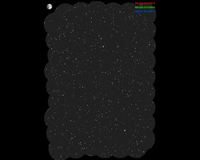Seach for transients aids BETA commissioning
|
The RGB version of the 150 sq degree image, |
30 January 2015
To demonstrate the rapid, wide-area survey capability of the Australian SKA Pathfinder (ASKAP) telescope, a new image of the Tucana constellation has been produced, over three times the size of previous efforts.
The demonstration was part of commissioning activities performed on the Boolardy Engineering Test Array (BETA) telescope – the first six ASKAP antennas installed with phased array feed (PAF) receivers at CSIRO’s Murchison Radio-astronomy Observatory (MRO).
“This a great demonstration of the rapid survey capability of the telescope and it also establishes the stability of the system when performing wide area surveys,” says Ian Heywood, ASKAP commissioning scientist, “Not only that, but it also serves as a pilot transient survey – similar to the sort of survey that VAST will be doing, but on a smaller scale.”
VAST – an ASKAP Survey for Variables and Slow Transients – is one of ten large Survey Science projects chosen for ASKAP, each designed to make use of the telescope’s unique capabilities. VAST will take advantage of the wide-field survey capabilities of the PAF in order to discover variable and transient phenomena from the local to the cosmological.
Over the course of a 12-hour observation, BETA was configured to deliver nine beams in a 3x3 square pattern, with the array spending five minutes on each of the twelve pointing positions (repeating each time a cycle is completed). This observation strategy returns an image of 150 square degrees with a (1-sigma) noise level of below 1 mJy, containing around 2000 sources brighter than 5-sigma.
Three separate observations were made in December 2014, and the resulting images from each were used to create a three colour RGB image. In such an image, sources that are fading would appear red, while brightening sources appear blue.
“In our image, the sources are mostly white, though there is some colour visible at the edge of the image where the noise is higher,” explains Dr Heywood, “While this might not be as exciting for fans of astrophysical transients it is extremely reassuring to us from a system stability point of view, and highlights the potential for using PAF-based interferometry for studying variable sources.”
A significant advantage of ASKAP is the rapid survey capability of the instrument and the wide field of view provided by PAFs. Not only will ASKAP be able to detect and investigate transient sources, but it will also have the potential to probe previously unexplored regions of phase space in order to discover new transient objects.
Back to Latest ASKAP News page.

